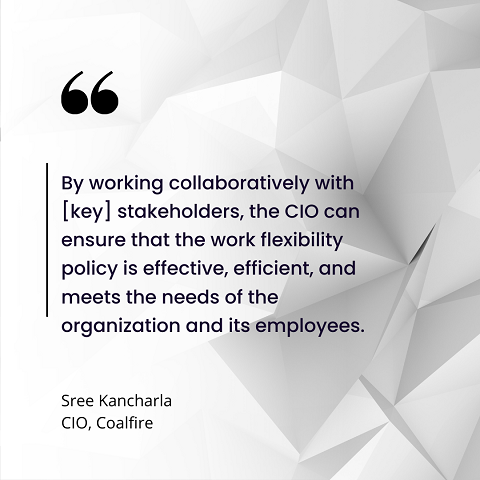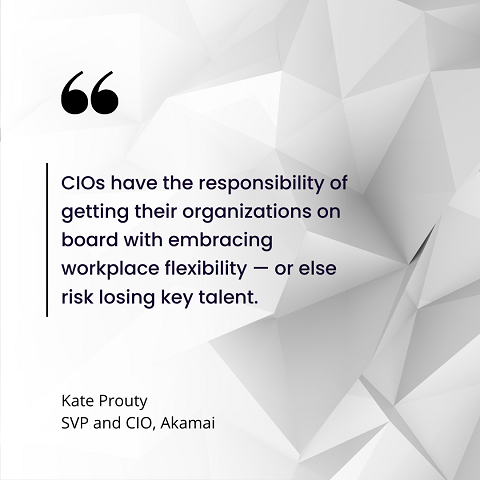Technology plays a significant role in enabling flexible work arrangements. That means the chief information officer can play a critical role in crafting a work flexibility policy.
As businesses continue to adapt to changing workplace expectations, technology is often the key to providing employees with the flexibility they need to achieve work-life balance.
CIOs have a deep understanding of the technological tools and infrastructure that are needed to enable remote work, flexible schedules, and other forms of work flexibility. They can use this expertise to identify the most effective technologies for enabling flexible work arrangements, and to ensure that these technologies are implemented and maintained correctly.
Work flexibility often involves integrating various systems, such as human resources, payroll, and benefits systems, according to Sree Kancharla, CIO at Coalfire.
"CIOs can help ensure that these systems work together seamlessly to provide a cohesive and effective work flexibility policy," she said.
Addressing the Security Challenges That Come with Work Flexibility
With remote work and flexible schedules come security challenges that CIOs must address, Kancharla said.
"CIOs can play a key role in ensuring that the technology solutions implemented to enable flexibility are secure and meet regulatory compliance requirements," Kancharla said.
Ensuring that such solutions are secure is becoming more important because work flexibility is now a key factor when it comes to employee satisfaction and retention, meaning it needs to be a priority if CIOs hope to retain their top IT workers.
As leaders, CIOs have the responsibility of overseeing the people, processes, and technologies within a company's IT organization, said Kate Prouty, senior vice president and CIO of Akamai Technologies.
"A proper work flexibility policy encompasses all three of these pillars, but where a CIO can really lend their expertise is making sure their organizational tech stack is equipped for a flexible work policy," she explained.
For hybrid and remote work to be successful, CIOs must equip employees with collaboration software tools to ensure distributed teams can efficiently and productively communicate, whiteboard, and manage projects.
CIOs Must Work with Multiple Stakeholders
There are several stakeholders who play a vital role in crafting a work flexibility policy, including HR professionals, managers, employees, and legal experts.
"To best partner with these stakeholders, the CIO should engage in regular communication and collaboration with each of them," Kancharla said.

The CIO should work closely with HR professionals to ensure that the technology solutions implemented to enable work flexibility are aligned with the organization's goals and policies.
"The CIO should also work closely with managers to ensure that the technology solutions are implemented effectively and that managers are trained to manage a remote or flexible workforce," she added.
Prouty pointed out that chief human resources officers (CHROs) or chief people officers "carry the torch" in creating a work flexibility policy that is inclusive of employee needs and reflective of a company's culture.
"Ultimately, the CIO can best connect the dots for these stakeholders to ensure that employees embarking on a flexible work journey are set up for success with the right technology, from collaboration tools to the right software and infrastructure," she said.
The CIO should also engage with employees to understand their needs and ensure that technology solutions are implemented in a way that supports their needs.
Finally, CIOs must partner with legal experts to ensure that the technology solutions implemented to enable work flexibility meet legal requirements.
"By working collaboratively with these stakeholders, the CIO can ensure that the work flexibility policy is effective, efficient, and meets the needs of the organization and its employees," Kancharla said.
Tech Talent Crunch Complicates Flexibility Policies
The IT talent crunch is complicating decisions around workplace flexibility because it is becoming increasingly difficult for organizations to find and retain skilled IT professionals.
Not only is having flexible work options important for retaining IT workers, but it is also important for attracting new IT talent currently on the job market. Without it, job seekers may wind up at a competitor that is offering workplace flexibility.
"By [offering flexible work arrangements], organizations can tap into a wider pool of talent that might not otherwise be available," Kancharla said.

The IT talent market is highly competitive, with many organizations vying for the same pool of talented professionals. So if they are to attract top IT talent, they must offer competitive compensation and benefits packages, and flexible work arrangements are increasingly becoming an important part of these packages, Kancharla said. Organizations that do not offer flexible work arrangements may struggle to attract top talent, as these arrangements are increasingly becoming an important factor in job satisfaction.
"Once an organization has hired skilled IT professionals, it is important to retain them," she said. "Flexible work arrangements can help organizations retain these professionals, as they allow them to achieve a better work-life balance."
Prouty also cautioned that organizations could sour strong IT talent by announcing mandatory return-to-office policies.
"Instead of driving well-performing employees out with these requirements, organizations should consider how critical it is to the job responsibilities to be in-person or in a designated location," she said. "Most of the time, it's possible to create a flexible option, especially within non-customer-facing IT roles."
An Evolving Challenge Requires Innovative Thinking
The issue of IT flight risk and workplace flexibility is likely to evolve in several ways in the coming years.
As more and more employees demand greater flexibility in terms of when and where they work, organizations will need to find new and innovative ways to accommodate these needs while also ensuring that their IT teams remain productive and engaged.
"I don't see the demand for workplace flexibility ending anytime soon — millions of workers now have firsthand experience of the benefits of remote and hybrid work options," Prouty said. "CIOs have the responsibility of getting their organizations on board with embracing workplace flexibility — or else risk losing key talent."
From her perspective, flexible workplace programs should be viewed as being mutually beneficial.
"On one hand, they benefit talent by offering employees a workstyle that best fits their personal situation," Prouty explained. "On the other hand, these programs benefit organizations by removing hiring barriers and allowing for top talent to be hired globally to strengthen the workforce."
Kancharla said one way that CIOs can think outside the box when it comes to reducing IT flight risk through workplace flexibility is by adopting a more flexible and adaptable approach to their IT operations.
This might involve using cloud-based services and software that allow employees to work remotely and collaborate more easily, or implementing more flexible working hours and policies that allow IT staff to work from home or other remote locations.
"Another important strategy is to focus on creating a more positive and supportive work culture that values and prioritizes employee well-being and work-life balance," she said.
This might involve providing access to resources and tools that help employees manage stress and maintain their mental and physical health, or offering more flexible schedules and leave policies that allow employees to take time off when they need it.
Ultimately, Kancharla said, the key to reducing IT flight risk through workplace flexibility is to be open to new ideas and approaches, and to actively seek out and embrace new technologies and strategies that can improve employee engagement and retention.
"By staying ahead of the curve and embracing new ways of working, CIOs can help ensure that their IT teams remain engaged, motivated, and productive, even as the nature of work continues to evolve and change," she said.
About the author
 Nathan Eddy is a freelance writer for ITPro Today. He has written for Popular Mechanics, Sales & Marketing Management Magazine, FierceMarkets, and CRN, among others. In 2012 he made his first documentary film, The Absent Column. He currently lives in Berlin.
Nathan Eddy is a freelance writer for ITPro Today. He has written for Popular Mechanics, Sales & Marketing Management Magazine, FierceMarkets, and CRN, among others. In 2012 he made his first documentary film, The Absent Column. He currently lives in Berlin.





